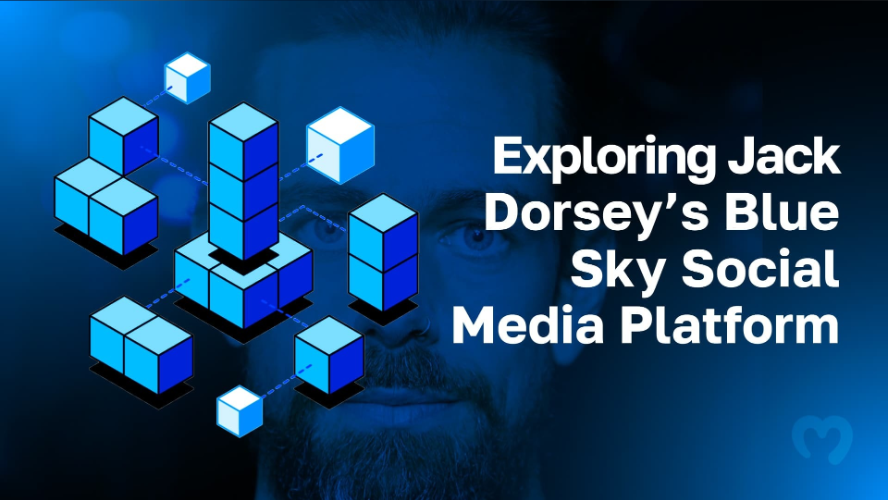Blockchain and Web3 technology are developing at rocket speed. Social media and other online platforms are adapting to keep up with the latest trend in technology. Take Jack Dorsey’s Bluesky social media platform for example. It’s like any other social media platform but with an upgrade. After selling Twitter to crypto and blockchain enthusiast, Elon Musk, Dorsey set his focus on developing a blockchain-based platform. Continuing with his signature blue-themed branding, Jack Dorsey’s Bluesky intends to connect all social media platforms via cross-platform technology. Akin to a Gmail account interacting with a Hotmail account, a blockchain platform based on a federated social network will allow users to create their own network with their own moderation and rules. We’ll discuss the juicy details and answer some burning questions in the following sections. But first, let’s take a closer look at the Bluesky social media platform and why Jack Dorsey is building it.
What is Jack Dorsey’s Bluesky Social Media Platform?
Leading with the idea of an “open and decentralized” social media platform, Jack Dorsey is working on the next generation of what social media could look like. The Bluesky social media platform is being built on a transparent and decentralized platform called the Authenticated Transfer Protocol (AT Protocol). This networking technology will provide access to several services, allowing users to communicate with other networks. Furthermore, users will have the freedom to create their own social platforms, governed by their own rules and regulations while simultaneously interacting with other platforms with ease.
Jack Dorsey’s primary objective in building the protocol is to give users control and transparency over their social media experiences. It’s what sets it apart from other social media platforms. How is that different from our current social media experience? Well, think of the ads that show up while browsing through the internet. Ads often seem as if they are individually hand-selected and presented to users at the perfect time. In reality, these ads are based on algorithms and data that track user behavior and place ads accordingly. This kind of data tracking and ad placement can be intrusive and sit on the fringe of privacy rights. According to its Twitter account, Bluesky aims to solve this problem by allowing users to control the algorithm.
Rumors are circulating that Dorsey competes with his former company, Twitter, but the facts say otherwise. Let’s dig deeper into what makes the Bluesky social media platform stand out from previous social media projects. In the next sections, we’ll take a look at how the AT Protocol creates an ideal network for the Bluesky social media platform.
What is The Authenticated Transfer Protocol?
The Authenticated Transfer Protocol, previously known as the “ADX,” integrates ideas from the latest blockchain technologies into an open network. The protocol is a new social network that provides a way for servers to communicate with each other, sort of like email platforms. AT Protocol is a federated network which means that the site can be run on multiple servers instead of just one. It also means that users can pick and choose which server they want to work with. Users can even self-host if they choose to.
AT Protocol Features
There are a few features that make AT Protocol unique. For one, its account portability. Users can move their data around from one server to another without losing data. Another unique feature of the AT Protocol is algorithmic choice. While users could not choose or create their own algorithms with traditional online platforms, AT Protocol allows users to have more control over their virtual social experience. To do this, it includes an open algorithm mode for users.
The third significant feature of the AT Protocol is interoperation. Interoperation is key for a smooth and flawless user experience. It’s needed for healthy virtual interaction among different platforms. The AT Protocol includes a schema-based interoperation framework called Lexicon to help solve coordination challenges. Finally, the fourth and final feature of AT Protocol is its scalability. Scalability is vital to any online platform. Users want fast, reliable service that doesn’t lag when demand is high. AT Protocol prioritizes scalability and aims to provide users with quick loading times and high-volume scalability.
Now that we have a better understanding of the AT Protocol, let’s take a look at what a decentralized social platform looks like. In the next sections, we’ll explore the history of social media platforms, what virtual interactions were like with the first generation of the internet, and what the future could hold for the third generation of virtual communities.
The History of Social Media Platforms
Social media has come a long way since its start in the late 1990s and early 2000s. The first platform to function like a social network, Six Degrees, allowed users to upload profile pictures and make friends online. Now, virtual social platforms provide much more. Users can create content, exchange goods, or even create a marketplace to sell new or used items. These platforms have revolutionized the way people across the globe interact with one another.
Like any big change, the rise of social media initially sparked fear about potential negative effects. Now, more than a third of the world’s population uses some form of an online social platform. The question remains whether the negative effects of social media are present, like mental health issues. On the flip side, social media is arguably a solution to many mental health issues as it has the potential to connect people with their loved ones no matter what part of the world they are in. It also holds the advantage of connecting people with opportunities and information that would otherwise be impossible to access. Below is an illustration of the US population and its use of technologies from 1930 to 2019.
So, what would the next generation of social media look like? In simple terms, the first generation of the virtual space allowed users to interact in a mostly read-only format. Internet users could visit websites and access information from any other part of the world that had the internet. In the second generation of the internet, users could post their own content via blogs, audio, and videos via a host website. Now, in the third generation of the internet, users have access and control over their own virtual experiences. Let’s dive deeper into what that means.
What Does a Decentralized Social Media Platform Look Like?
As mentioned above, previous social media technologies allowed users to initially experience the virtual space in a read-only format. Then, the development of the technology allowed users to share and create their own content via blogs, audio, and videos by using a host website. Now, with the third generation of the internet, or Web3, users have complete access and control over the servers they choose to use, the data, censorship, privacy rights, and algorithms within their networks.
In former years, centralized social media platforms have experienced data leaks that have exposed user data to third parties without their consent. Facebook, LinkedIn, and Instagram have had hackers take the personal and private information of users, causing havoc and a loss of trust among users of the platforms. In fact, Facebook lost more than 24% of its stock value soon after the security breach.
With decentralized technologies being built on the blockchain, users have the most-secure technology possible. Blockchain technology provides social media platforms an opportunity to put control of data into the hands of its most valuable asset- its users. Blockchain-based platforms are specifically designed to protect users from censorship restrictions and safeguard user data in the most promising way.
The third generation of virtual social interaction put control into the hands of its users. Federated networks, like the AT Protocol, foster independence without a central authority. A big advantage of this kind of network is that users can post freely without censorship restrictions. Simultaneously a downside, this will also mean that hate groups will have the freedom to post their content liberally as well. While other users can block such content, they can’t prevent such posts from engaging within the network.
Want to learn about Bitcoin and Blockchain fundamentals? Ivan taught this course to business leaders before beginning the Academy. Check it out and all that we have to offer at Moralis Academy.
What’s Next?
In order to survive the demands of the market, businesses must be willing to adapt to new technologies and solve current problems. Bluesky does just that. By pairing Bluesky social media with blockchain technology, Dorsey’s new platform could be the next generation of the virtual social media experience. Bluesky will provide a solution to the current privacy and data issues that many social media platforms face. On this network, users can create accounts without linking them to their personal identification, phone numbers, birth dates, or email addresses. Furthermore, users won’t have to rely on a centralized authority to secure their sensitive information.
Being built on a decentralized format and using a federated protocol like AT, Bluesky provides economic neutrality. While ads can generate income for many traditional online platforms, they can seem intrusive to the users’ privacy rights. Instead of ads, federated protocols like the AT Protocol utilize cryptocurrencies, like Bitcoin, to run operations. For example, TikTok pays its users to create content that adds value to the space. Paying creators incentivizes them to create quality content while also attracting more viewers and users to the platform. Investors who believe in the future of the platform, give the platform the funds it needs to operate.
The future of Bluesky and other Web3 social media platforms is looking bright. However, blockchain technology is still developing and changing for the better. It still has some challenges to overcome. Further developments and growth in technology will tackle some of the issues that naturally arise in the process of growth. In the following section, we’ll take a look at some of the disadvantages that come with decentralized spaces.
Decentralization, consensus algorithms, gas fees, these are all terms you’ll hear in the blockchain and cryptocurrency space. It can be intimidating if you’re not familiar with the territory. At Moralis, we’re dedicated to providing educational content for all. Check out our crypto terminology to learn about all the vocabulary you need to master the Web3 space.

Pros and Cons of Decentralized Social Platforms
Blockchain and decentralization have a plethora of advantages from immutability to complete user control. However, these advantages can quickly become a disadvantage if not implemented properly. The liberation from unwanted ads and the freedom of speech are all wonderful attributes of a decentralized platform until they escalate. The freedom to post any content one wants can lead the way to potential cyberbullying, hate speech, and further division among groups.
Blockchain technology and social media platforms can work harmoniously together to deliver optimal service to users around the world. There are still some challenges ahead for the technology to realize that potential. While blockchain technology is secure and reliable, no technology is 100% bulletproof. Ill-willed hackers will inevitably always pose a danger to the tech space. All in all, developers could tackle some of these issues with time and further research. Time will tell.
Have you seen our how to make a Web3 website guide? Find out all the things you can build through Moralis. We’ve got all the tools and resources you need to become a blockchain master.
Want to learn how to invest during a crypto bear market? We’ll teach you some of the best ways to navigate a bear market!
In Summary
Jack Dorsey’s Bluesky social media platform could solve the issues of censorship and privacy rights that most social media platforms currently face. It provides a scalable, reliable, and secure solution to handling user privacy, shared content, and economic neutrality. Bluesky provides its users the liberty to choose the server of their choice, securing their data as they wish instead of relying on one centralized authority to do so. Through its AT Protocol, Bluesky will enable users to interact with members of other blockchain networks similar to how Gmail users can communicate with Hotmail users.
Its federated network protocol, the AT Protocol, allows Bluesky to boast all of the advantages of blockchain technology. It’ll give users the advantage of creating an online experience that is governed by their own set of rules and regulations. Thanks to the algorithmic choice feature of the AT protocol, users won’t be bombarded with intrusive ads.
Social media users around the world can look forward to this next generation of the internet and make use of all its unique features. While this new generation of social interaction has advantages and disadvantages, it’ll be up to individuals and businesses to decide how they make use of the technology.
Check out our Web3 ebooks and blockchain guides!





